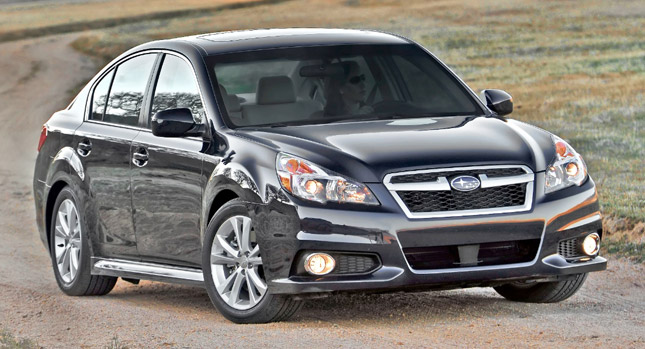The 2012 New York International Auto Show will see Subaru performing the world premiere of the updated 2013 Legacy sedan and Outback crossover models, both of which gain a newly developed 2.5-liter boxer four along with a new face and changes to the chassis and interior.
Subaru’s new 2.5-liter double-overhead-cam (DOHC) FB series boxer engine produces 173 horsepower and 174 lb.-ft. of torque, compared to 170hp and 170 lb.-ft. from the previous 2.5-liter SOHC engine. It can be combined with either a 6-speed manual gearbox or a second-generation Lineartronic CVT (continuously variable transmission).
While official EPA figures are still pending, Subaru projects that the 2013 Legacy 2.5i with the Lineartronic CVT will return 24 mpg city, 32 mpg highway and 27 mpg combined, compared to 23/31/26 for the 2012 model.
Similarly, the 2013 Outback 2.5i with the Lineartronic CVT will achieve 24 mpg city, 30 mpg highway and 26 mpg combined, an improvement of 2 mpg, 1 mpg and 2 mpg respectively over the 2012 model.
Aside from the 2.5L engine, both models will continue to be offered with a 256-horsepower 3.6-liter six-cylinder Boxer linked to a five-speed electronically controlled automatic transmission. All-wheel drive is standard on all models regardless of the engine.
According to the Japanese carmaker, the 2013 Legacy sedan benefits from numerous enhancements to the body structure, suspension, and steering to improve comfort and provide a quieter ride. Similar changes were made to the Outback’s chassis.
Subaru has made some subtle styling tweaks to the fascias of the two models with revised headlights, grille and front bumper. Inside, the Legacy and Outback crossover feature new seat fabrics, a new electro-luminescent instrument cluster in certain trims and some other minor equipment upgrades across the range.
Both cars also get Subaru’s new EyeSight driver-assist system, which integrates Adaptive Cruise Control, Pre-Collision Braking and Vehicle Lane Departure Warning, and uses a stereo camera design to provide a wider detection angle than that of radar-based systems.
PHOTO GALLERY





